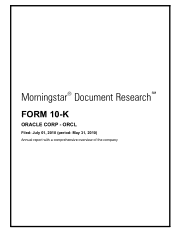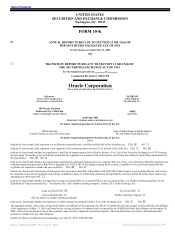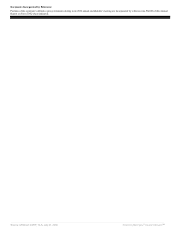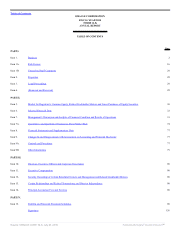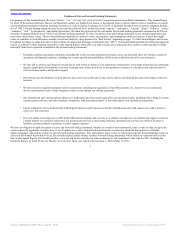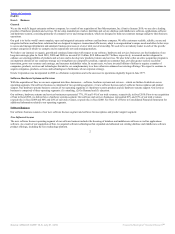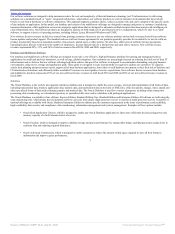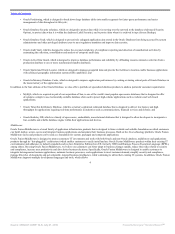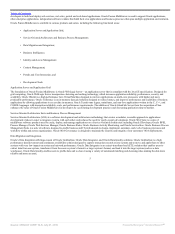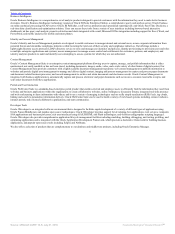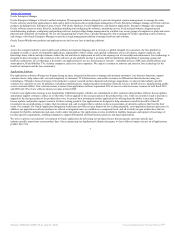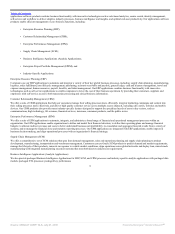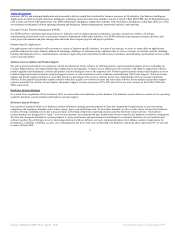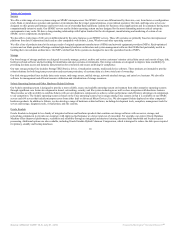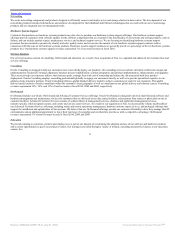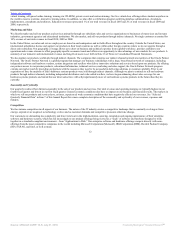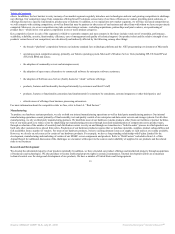Oracle 2009 Annual Report Download - page 8
Download and view the complete annual report
Please find page 8 of the 2009 Oracle annual report below. You can navigate through the pages in the report by either clicking on the pages listed below, or by using the keyword search tool below to find specific information within the annual report.
Table of Contents
• Oracle Partitioning, which is designed to break down large database tables into smaller segments for faster query performance and easier
management of data throughout its lifecycle;
• Oracle Database Security solutions, which are designed to protect data while it is moving over the network to the database (Advanced Security
Option), to protect data when it is within the database (Label Security), and to protect data when it is archived to tape (Secure Backup);
• Oracle Database Vault, which is designed to pro-actively safeguard application data stored in the Oracle Database from being accessed by system
administrators and other privileged database users to meet regulatory mandates and improve data security;
• Oracle Audit Vault, which is designed to reduce the cost and complexity of compliance reporting and detection of unauthorized activities by
automating the collection, consolidation and analysis of enterprise audit data;
• Oracle Active Data Guard, which is designed to improve database performance and reliability by offloading resource-intensive activities from a
production database to one or more synchronized standby databases;
• Oracle Spatial and Oracle Locator, which are designed to manage geospatial data and provide the facilities to location enable business applications
with advanced geographic information system (GIS) capabilities; and
• Oracle In-Memory Database Cache, which is designed to improve application performance by caching or storing critical parts of Oracle Database in
the main memory of the application tier.
In addition to the four editions of the Oracle Database, we also offer a portfolio of specialized database products to address particular customer requirements:
• MySQL, which we acquired as part of our acquisition of Sun, is one of the world’s most popular open source databases that is designed to offer
developers a simple to use, horizontally-scalable database often used to power high-volume applications such as websites and web-based
applications;
• Oracle TimesTen In-Memory Database, which is a memory-optimized relational database that is designed to deliver low latency and high
throughput for applications requiring real-time performance in industries such as communications, financial services and defense; and
• Oracle Berkeley DB, which is a family of open source, embeddable, non-relational databases that is designed to allow developers to incorporate a
fast, scalable and reliable database engine within their applications and devices.
Middleware
Oracle Fusion Middleware is a broad family of application infrastructure products that is designed to form a reliable and scalable foundation on which customers
can build, deploy, secure, access and integrate business applications and automate their business processes. Built on the Java technology platform, Oracle Fusion
Middleware suites and products can be used as a foundation for custom, packaged and composite applications.
Oracle Fusion Middleware is designed to protect customers’ IT investments and work with both Oracle and non-Oracle database, middleware and applications
products through its “hot-pluggable” architecture (which enables customers to easily install and use Oracle Fusion Middleware products within their existing IT
environments) and adherence to industry standards such as Java Enterprise Edition (Java EE, formerly J2EE) and Business Process Execution Language (BPEL),
among others. By using Oracle Fusion Middleware, we believe our customers can better adapt to business changes rapidly, reduce their risks related to security
and compliance, increase user productivity and drive better business decisions. Specifically, Oracle Fusion Middleware is designed to enable customers to
integrate heterogeneous business applications, automate business processes, scale applications to meet customer demand, simplify security and compliance,
manage lifecycles of documents and get actionable, targeted business intelligence, while continuing to utilize their existing IT systems. In addition, Oracle Fusion
Middleware supports multiple development languages and tools, which allows
4
Source: ORACLE CORP, 10-K, July 01, 2010 Powered by Morningstar® Document Research℠

